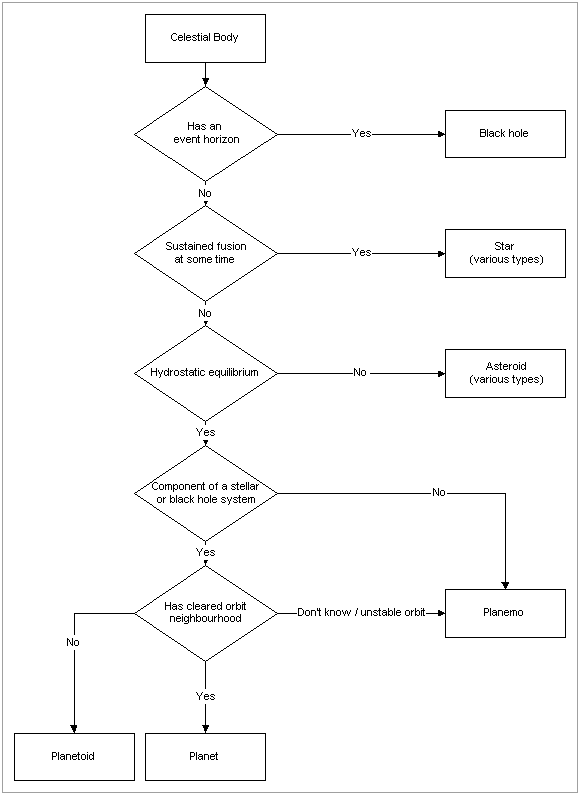
| This page is intended to explore the possibility of a basic definitional system for individual celestial bodies ranging from black holes to the smallest asteroids. It starts from the IAU definitions agreed by Resolution 5A of the 2006 General Assembly and structures them in a manner conducive to incorporating extra-solar bodies. To simplify the presentation and minimise ambiguity, a number of alternative names have been adopted but these should be seen as equivalent to the IAU terms. These are: |
|
| The hierarchy of the definitional structure is illustrated in the following flowchart and associated footnotes: |

| 1. | The term "Sustained fusion" indicates that the body should be capable of fusion in an equilibrium state. Bodies which are close to the lower boundary for fusion of deuterium could possibly undergo a brief period of fusion should transient over-pressure occur during the process of formation but this should not qualify the object to be classified as a star. |
| 2. | The phrase "at some time" is intended to include stars currently fusing material, those that have fused in the past including neutron stars and white dwarfs and individual objects ("proto-stars") which have conditions suitable to fuse some element (notably deuterium) in the future but are still in the process of gravitational collapse. It excludes combinations of objects such as a binary configuration of objects which may achieve fusion should they merge (for example a binary system of two objects each of mass 50 MJ). |
| 3. | The details of what constitutes a "stellar or black hole system" require further consideration. |
| 4. | It is implicit in the IAU distinction between a planet and a dwarf planet (herein ‘planetoid’) which is based on the object have "cleared the neighbourhood of its orbit" that the object have a well-defined orbit to clear. Neither name is therefore applicable to free-floating objects such as "sub-brown dwarfs" as defined by the Working Group on Extrasolar Planets (WGESP) of the IAU. The mass range for all three types is common with the upper bound set by the limiting mass for thermonuclear fusion of deuterium and the lower bound set by the requirement for self-gravity to achieve a surface close to hydrostatic equilibrium. The generic term "planemo" suggest by Basri is adopted for objects within that mass range but which either do not have a well-defined orbit (free-floating or chaotic) or whose environs cannot be observed with sufficient confidence to determine whether the neighbourhood of the orbit has been cleared. |
| 5. | The criteria for an object to be a planetoid are based on dynamics. Two types of planetoid can be identified based on the method of formation. Objects which were formed directly by accretion in the circum-stellar disc can be considered to be remnant protoplanets. An alternative origin is that such objects can be produced as the result of impacts between protoplanets by spallation. While the masses and dynamics are similar, the composition of such spallated planetoids can differ significantly. |
| 6. | The generic description "moon" has been variously defined as "Any natural satellite of a planet.", "A naturally occurring satellite, or relatively large body, orbiting a planet.", "A small body in orbit about a planet." and "A natural celestial body having a regular orbit around another larger body, such as a planet.". The suggestion is made that the term "moon" be applied to larger satellites only and that the ‘nearly round’ criterion be adopted as the discriminator. The extension of the definition to planetoid as well as planets would include Charon as a moon of Pluto. Alternatively, existing definitions would suggest that "moon" should be applied to a satellite of any size provided only that it orbits a planet for which a strict interpretation includes every particle in planetary ring systems a "moon" but would preclude its application to Charon as Pluto is not a planet. An alternative lower mass limit would be required if "shepherd moons" in ring systems are to retain that classification in a consistent manner. |
| Example Types of Star | |
| Brown Dwarf | An object capable of sustained fusion of deuterium but not sufficiently massive to fuse hydrogen. These can be further subdivided by their formation into "primary" where the form directly by condensation from a nebula or as "secondary" where they form in the disc of a larger object. |
| Main Sequence | (definition to be completed) |
| Blue Straggler | A star formed by the merger of two smaller stars. |
| White Dwarf | (definition to be completed) |
| Neutron Star | (definition to be completed) |
| Magnetar | (definition to be completed) |
| Example Types of Asteroid | |
| Main Belt | Object whose orbit lies in the approximate range 2AU to 4AU. |
| Kuiper Belt Object (KBO) | Object whose orbit lies in the approximate range 30AU to 50AU. |
| Comet | A comet can be viewed as a type of asteroid depending on both orbit and composition, details to be completed. |
| Meteoroid | (definition to be completed) |
| TNO | Trans-Neptunian Object |